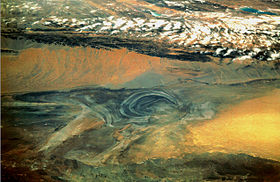
Back بحيرة لوب نور Arabic Lobnor gölü Azerbaijani Лобнор Bulgarian Lob Nor Catalan Lobnor Czech Lop Nor German Lop Nor Esperanto Lop Nor Spanish Lop Nur Estonian Lop Nor Basque
| Lop Nur | |||||||||||
|---|---|---|---|---|---|---|---|---|---|---|---|
 Satellite picture of the Basin of the former sea of Lop Nur; the concentric shorelines of the vanished lake are visible. | |||||||||||
Location of Lop Nur within Xinjiang | |||||||||||
| Chinese name | |||||||||||
| Traditional Chinese | 羅布泊 | ||||||||||
| Simplified Chinese | 罗布泊 | ||||||||||
| |||||||||||
| Alternative Chinese name | |||||||||||
| Traditional Chinese | 羅布淖爾 | ||||||||||
| Simplified Chinese | 罗布淖尔 | ||||||||||
| |||||||||||
| Mongolian name | |||||||||||
| Mongolian Cyrillic | ᠯᠣᠪ ᠨᠠᠭᠤᠷ Лоб Нуур | ||||||||||
| Uyghur name | |||||||||||
| Uyghur | لوپنۇر | ||||||||||
| |||||||||||
Lop Nur or Lop Nor (from a Mongolian name meaning "Lop Lake", where "Lop" is a toponym of unknown origin[1]) is a now largely dried-up salt lake formerly located in the eastern fringe of the Tarim Basin in the southeastern portion of the Xinjiang Autonomous Region, northwestern China, between the Taklamakan and Kumtag deserts. Administratively, the lake is in Lop Nur town (Chinese: 罗布泊镇; pinyin: Luóbùpō zhèn), also known as Luozhong (罗中; Luózhōng) of Ruoqiang County, which in its turn is part of the Bayingolin Mongol Autonomous Prefecture.
The lake system, into which the Tarim River and Shule River drain from the west and east respectively, is the last remnant of the historical post-glacial Tarim Lake, which once covered more than 10,000 km2 (3,900 sq mi) in the Tarim Basin but had progressively shrunk throughout the Holocene due to rain shadowing by the Tibetan Plateau. Lop Nur is hydrologically endorheic, it is landbound and has no outlet, and has relied largely on meltwater runoffs from the Tianshan, Kunlun and the western Qilian Mountains. The lake measured 3,100 km2 (1,200 sq mi) in 1928, but has dried up due to construction of reservoirs which dammed the flow of water feeding into the lake, and only small seasonal lakes and salt marshes may form. The dried-up Lop Nur Basin is covered with a salt crust ranging from 30 to 100 cm (12 to 39 in) in thickness.
An area to the northwest of Lop Nur has been used as a nuclear testing site.[2] Since the discovery of potash at the site in the mid-1990s, it is also the location of a large-scale mining operation.[3] There are some restricted areas under military management and cultural relics protection points in the region, which are not open to the public.[4]
- ^ Barber, Elizabeth (2000). The Mummies of Urümchi. W. W. Norton & Company. p. 125.
Two groups have laid claim to nor, the second half of Lop Nor. Nor is Mongol for 'lake' and occurs as part of many lake names in Xinjiang and other parts of Central Asia, while nur is Uyghur for 'bright' (as in the white of the salt flats). Mongol probably wins this one. But lop is opaque in both languages and in Chinese too, a fact suggesting that the name goes back to a time before Turks, Mongols, or Chinese had entered the territory.
- ^ "Lop Nor Nuclear Weapons Test Base". nti. Retrieved 3 August 2007.
- ^ "Lop Nur, Xinjiang, China". Earth Observatory. 19 June 2011.
 This article incorporates text from this source, which is in the public domain.
This article incorporates text from this source, which is in the public domain.
- ^ 三问哈罗铁路. Sina Weibo. 《新疆哈密广播电视报》. 6 December 2012.
© MMXXIII Rich X Search. We shall prevail. All rights reserved. Rich X Search

